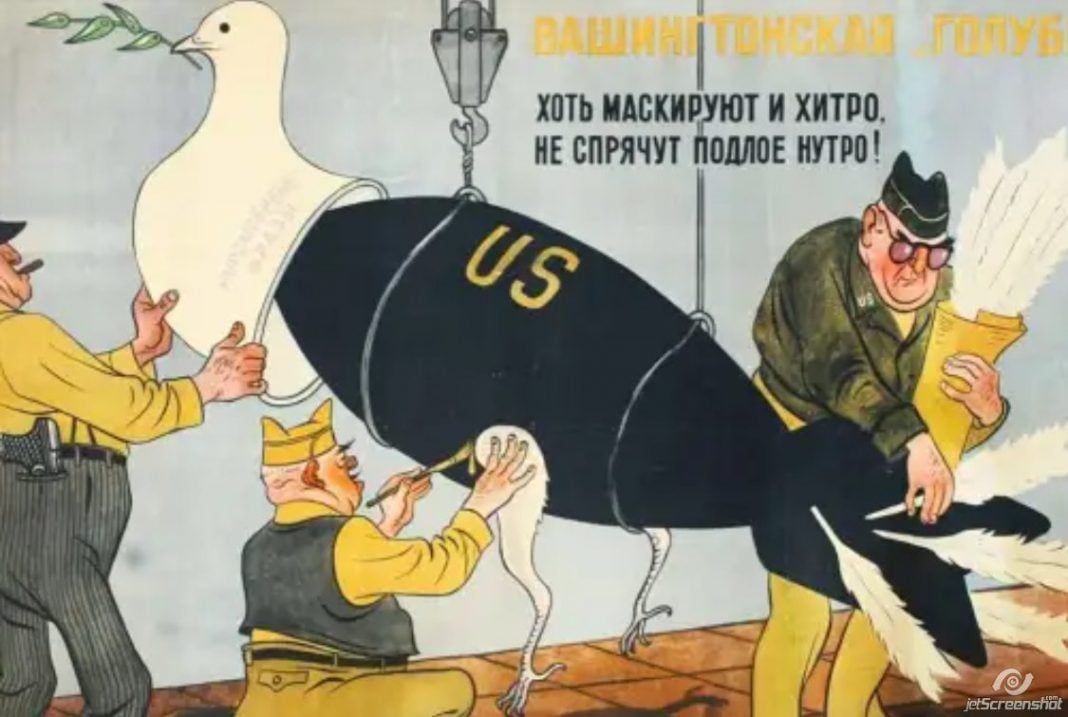By Thomas Kent, for CEPA
It’s one of the curiosities of the information war that for many years the US did not respond in kind to Russian propaganda targeting US citizens. This was largely a red line of America’s own making, reflecting concerns that by directly addressing the Russian people, it would unnecessarily provoke Vladimir Putin. Or that such campaigns just wouldn’t work.
Wars change things.
In recent months, the State Department has produced a stream of forceful video messages aimed at Russian citizens. Some juxtapose statements by Putin with evidence he is lying. Some end with slogans like “The truth always wins” and “Protect your future. End the killing. Stop the war.” One simply contrasts Putin making a statement (that sanctions are failing) with his own central bank chief saying the opposite.
At least two videos use what appear to be intercepted telephone conversations. In one, a Russian soldier describes the bodies of Russian troops stacked up in a Ukrainian garbage dump. In another, a soldier’s frontline experiences of desertions and casualties are contrasted with Putin’s denials.
https://www.youtube.com/embed/l_Ove1dxPDg?feature=oembedVideo: Russian soldier describes the bodies of Russian troops stacked up in a Ukrainian garbage dump. Credit: ShareAmerica via YouTube
Responding to one video, Dmitry Medvedev, deputy head of Putin’s Security Council, declared that “the sons of bitches delivering such nonsense are the real heirs of the Reich Minister of Propaganda Joseph Goebbels.” A senior Duma deputy said the video was masked in “sheep’s clothing,” and amounted to incitement to riot.
On January 30 and February 7, the Foreign Ministry demanded that the US embassy “strictly observe” Russian law. It threatened to use all available resources to “neutralize” the embassy’s “rabid anti-Russian propaganda,” a reference to its distribution of the videos.
The videos have also been published on State Department platforms and on YouTube, which is not yet banned in Russia.
The current Russian regime, like its Soviet predecessors, has long accused Western nations of using psychological tactics to undermine Russian unity — accusations that may reveal more about government fears than actual US and allied policy.
Usually, Moscow’s ire is directed at news outlets like the BBC and Radio Free Europe/Radio Liberty. Although the Kremlin hardly likes the stories these outlets cover, their format is basically that of news organizations. Their editorial independence means governments can’t dictate their content.
The State Department videos are different. They are official, government-branded products.
The US message that angered Medvedev, issued January 4 and running less than a minute, is titled “To the people of Russia.” The video starts with images of past US-Russian partnerships in World War II, in culture and space. It then switches to scenes of devastation in Ukraine with the caption: “We do not believe what is happening is worthy of you.” The video ends with the chants of Russian anti-war demonstrators and the text “We are with all of you struggling for a more peaceful future.”
Posts containing the video racked up more than a million views on the embassy’s Telegram and Twitter channels, though it’s not clear how many of those views came from inside Russia. The numbers could conceivably have been boosted by curiosity over what top officials were complaining about so much.
Analysts of Russian public opinion have long disagreed over what messages about the war might resonate best with Russian citizens. The US videos represent a mix of approaches, perhaps aimed at testing various alternatives.
Some believe Russians who have bought into the Kremlin’s propaganda are best approached gently, like people drawn into a cult. For those with such an outlook, reminders of past US-Russian friendship could conceivably be more effective than direct attacks on Putin.
Other Russians care little about the war but might respond to messages about the damage it is wreaking on the Russian economy. Images of death and destruction in Ukraine can elicit sympathy but are confronted by counter-claims in Kremlin propaganda that Russia is in a life-or-death struggle against a combined Ukraine-NATO army.
The videos do provide information about the war to Russians, who often know appallingly little about it. (Nearly half are unaware that Putin was indicted for war crimes.)
Given Putin’s suffocating security apparatus, it is unlikely the videos will have much on-the-ground effect by themselves. But such efforts — combined with a steady flow of bad news about the war reaching Russians from other sources — could affect citizens’ thinking over time.
Russia’s government is widely believed to closely monitor its citizens’ attitudes. If they become less patient with an increasingly costly war or continue to harbor memories of better relations with the US, such feelings could eventually weigh on calculations inside the Kremlin — under Putin or a successor.
To maintain an enduring audience for the US messages, however, much depends on the promotional muscle behind them. Winning eyeballs on social networks requires a marketing investment, and the ability to target certain videos to the population segments where they will be most effective. If the videos are to have a continuing effect, the US must make sure they are seen.
By Thomas Kent, for CEPA
Thomas Kent is a consultant on Russian affairs and the information war, and teaches at Columbia University. He is a former president of Radio Free Europe/Radio Liberty. His book, ‘Striking Back: Overt and Covert Options to Combat Russian Disinformation,’ was published by the Jamestown Foundation, where he is a senior fellow.
Europe’s Edge is CEPA’s online journal covering critical topics on the foreign policy docket across Europe and North America. All opinions are those of the author and do not necessarily represent the position or views of the institutions they represent or the Center for European Policy Analysis.





